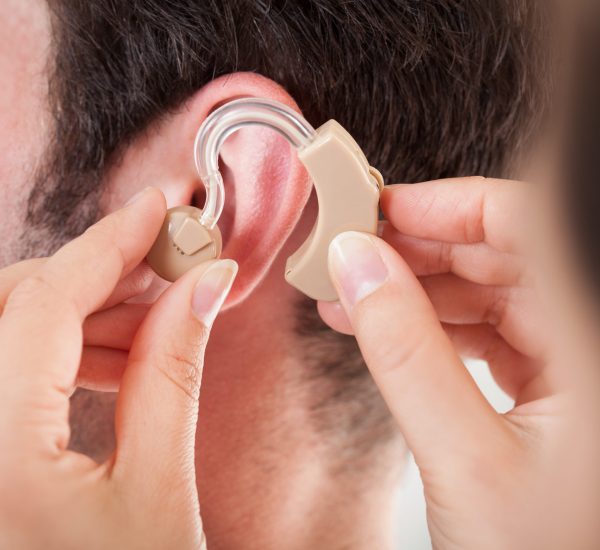Hearing aids: the solution to hearing loss
A hearing aid is an electronic device which is powered by batteries and it is designed to improve the hearing by making sound audible to a person with hearing loss. Hearing aids are classified as medical devices in most countries, and regulated by the respective regulations. Modern devices are computerised electroacoustic systems that transform environmental sound to make it audible, according to audiometrical and cognitive rules. Modern devices also utilize sophisticated digital signal processing to try and improve speech intelligibility and comfort for the user. Such signal processing includes feedback management, wide dynamic range compression, directionality, frequency lowering, and noise reduction. Modern hearing aids require configuration to match the hearing loss, physical features, and lifestyle of the wearer. The hearing aid is fitted to the most recent audiogram and is programmed by frequency. This process is called “fitting” and is performed by a Doctor of Audiology, also called an audiologist . The amount of benefit a hearing aid delivers depends in large part on the quality of its fitting.

Hearing aids are used for a variety of pathologies including sensorineural hearing loss, conductive hearing loss, and single-sided deafness. Hearing aid candidacy is typically determined by a Doctor of Audiology or an Audiologist, who will also fit the device based on the nature and degree of the hearing loss being treated. The amount of benefit experienced by the user of the hearing aid is multi-factorial, depending on the type, severity, and etiology of the hearing loss, the technology and fitting of the device, and on the motivation, personality, lifestyle, and overall health of the user.
Hearing aids are incapable of truly correcting a hearing loss; they are an aid to make sounds more audible. The most common form of hearing loss for which hearing aids are sought is sensorineural, resulting from damage to the hair cells and synapses of the cochlea and auditory nerve. Sensorineural hearing loss reduces the sensitivity to sound, which a hearing aid can partially accommodate by making sound louder. Other decrements in auditory perception caused by sensorineural hearing loss, such as abnormal spectral and temporal processing, and which may negatively affect speech perception, are more difficult to compensate for using digital signal processing and in some cases may be exacerbated by the use of amplification.Conductive hearing losses, which do not involve damage to the cochlea, tend to be better treated by hearing aids; the hearing aid is able to sufficiently amplify sound to account for the attenuation caused by the conductive component. Once the sound is able to reach the cochlea at normal or near-normal levels, the cochlea and auditory nerve are able to transmit signals to the brain normally
Types of hearing aids
All hearing aids work according to the same principle: they pick up ambient noise, the sound is converted into electrical impulses and then forwarded, in a modulated form, to the ear. However, depending on the severity of the hearing loss and personal requirements, hearing aids can differ considerably. Not just in terms of shape and size, but also in terms of their properties and functions. This diversity ensures a solution that meets your desires and expectations. Which is the best hearing aid for you? Take a look at what’s available!
Based on the design, technology and the features they provide, hearing aids can be classified into multiple types. Hence, it’s possible to get the most suitable hearing aid, by taking a quick glance at the advantages and disadvantages of each type.

Hearing Aids Based on Design
Behind-the-ear (BTE) aids: It is worn behind the ears. It comprises a narrow transparent tube, which carries thin wires, connecting the casing to the receiver that rests in the ear canal.
Worn behind the ears
Suitable for children
Easy to clean & maintain
Mini BTE (also called on-the-ear) aids: This is a new type of BTE hearing aid that rests behind the ear, only it’s a little smaller and the tube connecting the casing to the earmold is even thinner.
- Worn behind the ears
- Smaller than BTE hearing aids
- Less visible than BTE
In-the-ear (ITE/RITE) aids: For these type of hearing aids, all the components are contained in a case and placed in a way that fills the outer ears completely. These devices use larger batteries to support a more powerful receiver.
- Less visible than BTE & Mini-BTE
- Ideal for profound hearing loss.
In-the-canal (ITC) aids: This kind of hearing aids are worn in the lower side of the outer ear. With a medium size fit, these devices are easily inserted and removed when needed.
- Worn in the lower side of the outer ear
- Less visible than ITE
- Comes with longer battery life
Completely-in-the-canal (CIC) aids: These devices sit hidden within the ear canals and amplify the natural hearing ability of the ear. CIC hearing aids use very small batteries.
- Worn inside the ear canal
- Less visible than ITC
- Perfect for moderate hearing loss
Invisible-in-canal (IIC) aids: This type of hearing aid sits deep inside the ear canal, making itself almost invisible. These devices are the tiniest form of hearing aids available.
- Worn deep inside ear canal
- Almost invisible
- Equipped with powerful features